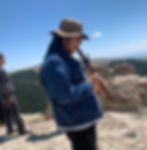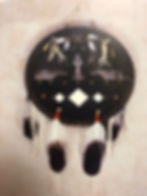Center for Helping the Youth
Weaving Traditional Values into Modern Life Skills
Pine Ridge Reservation

Culture and Sacred Places

First Time Sewing


Culture and Sacred Places
"Those of us who know the teaching and cherish the ways of the old people, we choose to honor ourselves as women by putting that skirt on, and we know that there's something for our children when they see us being proud of who we are as women, and I think that is the greatest teaching."
Lakota Woman
PROJECTS - PROGRAMS - ACTIVITIES
OUR MISSION STATEMENT: To Inspire our Lakota Youth to become Leaders for their future, to teach and share our Lakota Values, Virtues, Cultural, and Spiritual Wisdom and our Lakota Way of Life through our Circle of Knowledge.
Serving boys and girls ages 5-26, we weave traditional Lakota values into Modern Life Skills.
Our activities and events are offered indoors at our headquarters. Outdoor activities include field trips to sacred places and
summer camps.
We teach an "inside the center" approach to life.
We teach our Lakota Ways to our young people, to help them learn and remember who we are and where we came from.
We teach them about the treaties and how to become Protectors of our way of life as well as our Natural Resources.
We teach them to know Unci Maka, “Grandmother Earth”.
Leadership Skills

Leadership values are very important to us as Lakota Oyate (People). You must have a good mind, heart, are humble and believe in your people. A good leader is chosen by his people for doing good deeds and being compassionate. A leader thinks of his people first. The children, elders, and the women. He teaches and helps young men to become humble leaders with help from the people.
It takes a community to guide the youth to become leaders. In today’s society this still is the way it should be. We need this way of thinking and being.
As a Nation we must continue to teach leadership to our Lakota youth. They are our future. The way of our Ancestors. We are Indigenous.
-
A Youth Leadership Board is being developed. They will vote for their own officers and decide on activities that reflect the mission and purpose of our organization. They will send a representative to the adult Board meetings where their proposed activities will be presented to determine if they are feasible, follow Lakota Values and meet the mission of Teca WaWokiye Cokata.
-
Sina Luta Woihanble (Red Shawl Dreams) female youth sewing skills classes.
-
Inyan Luta Tokalas (Red Rock Warriors) male youth cultural program.
-
Talking Circles - A Talking Stick is held with humbleness and honor. It is used to help the youth learn to listen while another youth is talking. It teaches respect for the youth communicating his thoughts or ideas. No one is to speak except the person holding the stick. The youth talking holds a Talking Stick until finished speaking. The stick is then passed to the next person to the left. Each person will have a turn.
Sewing
When the build out is complete on our new building, we will again offer sewing classes to community girls.
Skilled and caring volunteers will guide the participants through basic sewing skills and safe operation of a sewing machine.
For their first project, the girls learn how to make traditional ribbon skirts for their dolls. Each girl will have her own doll. She will choose her own material and ribbons. The finished dolls will have hair made from yarn and the girls will be outfitting the whole doll with hair ties, moccasins and leggings.
The silhouette of the skirt itself comes from a sacred place, and it follows the outline of the tipi. The bottom of the skirts would touch the earth's medicines, and as the women walked, "Mother Earth would always know who it was that was making their presence felt on her back" and the prayers were answered accordingly.

Lakota Plants and Foods
The Lakota Plants are sacred to our people and are used to heal us when we are sick, physically, mentally, emotionally, even spiritually. The plants are alive and many grow near water and come from Unci Maka (Grandmother Earth) and the plants have spirits. They are healers of our mind and body. When we use them in a good way our prayers are answered. This is the Medicine.
Harvesting and Teachings
-
Medicinal Uses for our Lakota Plants and Foods, such as Sweetgrass, Chokecherries, Red Willow, Sage, Woman’s Sage, Cedar, and other wild plants for Medicine.
-
Purposes, preparations, drying and storing (Winter, Spring, Summer, Fall)
Buffalo, Elk, and Deer Meat
-
Preparing, drying and storing
-
Making Wasna from dried buffalo meat and dried chokecherry patties and buffalo kidney fat

Lakota Art and Culture
-
Hide preparations
-
Drum making and Drum sticks
-
Medicine pouches, Ceremonial pouches and Bags
-
Bow and Arrow making
-
Parfleche making
-
Moccasins and Legging Making
-
Quillwork
-
Lakota Storytelling
-
Lakota Star Knowledge
-
Teepee, setting up and taking down






Sacred Places - Sacred Experiences
"The mountain call Mato Paha (Bear Butte), has been considered a sacred place to the Lakota and the Cheyenne. The history goes back beyond Crazy Horse, we the Lakota believe that the great bear has gone to sleep in this spot and brings dreams of hope and identity to our people. And when he breathes we can feel the breath which will give our women with child, twins, as well as the animals who live in the surrounding area. The Lakota and the Cheyennes seek wisdom and strength from this Sacred Place, and it is given. We also give our Wakanyeja (children) Sacred names and Hunka (adopt) new family members to strengthen our Tioyspaye (Family).
This is the place to teach our children about our past as well as our future."
- Fred Menard
Bear Butte Spiritual Camp
-
Seven Sacred Rites
-
Hunka Ceremony/Lakota Naming Ceremony
-
Inipi’s/Lakota Pipe Ceremony
-
Hanbleceya
-
Wakanyeja Anpetu - Children’s Day
Pipestone, Minnesota
-
Instruction of Lakota Sacred Pipe
-
White Buffalo Calf Woman Sacred Teachings
Lakota Language
-
Lakota Language and Song is used throughout Ceremony with Interpretation
Full Moon Inipi Ceremony - Hanhepi Memela Wi
-
Gathering Wood for Inipi’s and Ceremony

